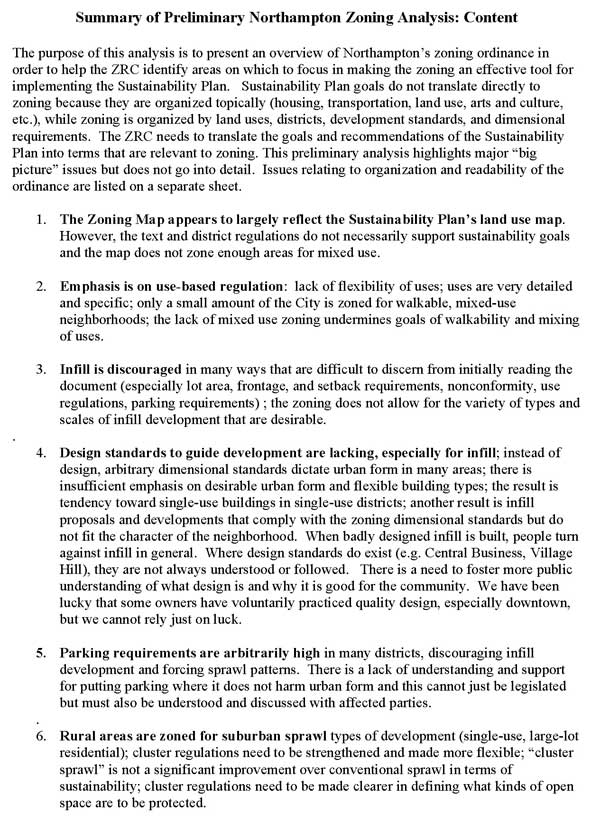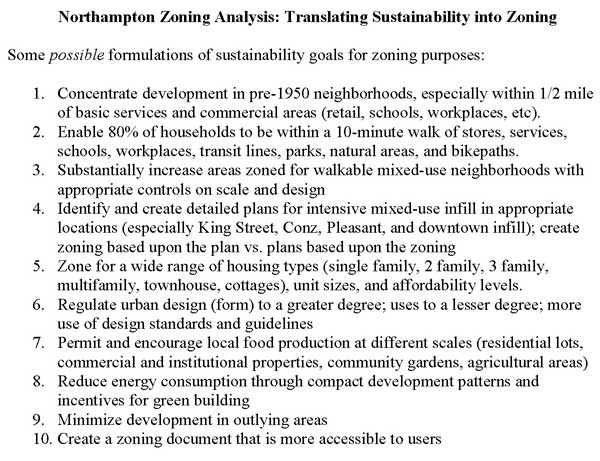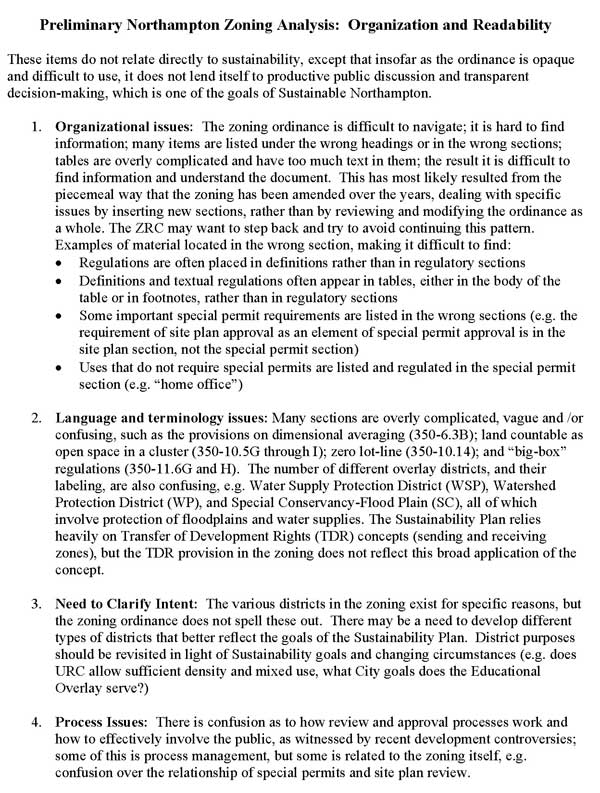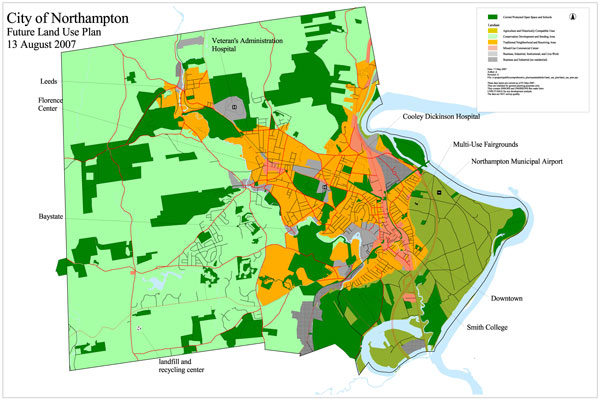Here is a complete blip.tv video of the 10/28/09 meeting of Northampton’s Zoning Revisions Committee. This video is 2 hours 1 minute long and was recorded by Adam Cohen. The next meeting will take place on November 4 in the Bridge Street School Cafeteria at 7:00pm. The 11/4 agenda includes:
1. Public comment
2. Subcommittee reports
3. Planning for a public input session in January; set date, create agenda and outreach process
4. Discussion of what ZRC’s “production process” and timeline will be
5. Discussion of geographic demonstration/study areas
Here is the agenda of the 10/28/09 meeting:
Zoning Revisions Committee Meeting
October 28, 2009 Agenda
City Council Chambers
7:00 PM
1. Public comment
2. Announcements
a. November 12 meeting with Planning Board on design issues
b. Future meetings and staffing
3. Subcommittee check-in
4. Analysis of current Northampton Zoning Ordinance
a. Finish presentation on barriers to infill (Danielle)
b. Finish overview (Joel)
c. Translating sustainability goals into zoning (Joel)
5. Task list
a. Public input forum
b. Subcommittee reports
c. Final product and timeline
Below is a handout distributed by committee chair Joel Russell (download as a PDF, 20KB). See also Danielle Kahn’s presentation, “Barriers to Urban Infill in URC” (PDF, 364KB).


While there is much to be praised here, we suggest the following to ease the way politically and safeguard the “receiving areas” (see map below):
- Give people positive reasons to live and work in the receiving areas (beyond any environmental or aesthetic benefits of curtailing sprawl). These might include:
- Access to next-generation Internet service
- Free wifi for homes, businesses and the public
- Robust tree-planting program (see benefits)
- Frequent clean-up of graffiti and trash (see ‘broken windows’ theory)
- Free snow-clearing from sidewalks
- Snow-clearing from bike trails
- Prioritize the enactment of infill design guidelines
- Prevent awkward, inappropriate, overlarge infill developments
- Preserve urban greenspace
- Avoid increasing density to levels that lead to traffic jams and parking shortages
- Restrict the spread of impervious surface to reduce flooding risks and the urban heat-island effect
See also:
Proposed Future Land Use Map (PDF)
The orange zones are “Traditional Neighborhood and Receiving Areas”. The light green zones are “Conservation Development and Sending Areas”.

Video Highlights from the 10/19/09 Mayoral Debate: Wetlands, King Street, Infill and the BID
Question: “Every town and city in the United States wishes they had more open space in their downtowns, believing that even little parks or open areas make a city more livable. They also attract people who want to live or frequent that city. Seemingly, Northampton does not have the same outlook as other communities. How did the infill theory for growth of the business district morph into an infill theory for all of the residential areas that surround the business district? Besides local developers and real estate agents, how does this infill benefit the current citizens and taxpayers of Northampton who live in these areas?”
Higgins: “I agree with Councilor Bardsley that we need to think about design standards. I think we need to think about density…and I think we need to think about things like greenspace and trees.”
Bardsley: “I think we need design standards… Infill isn’t simply cramming in buildings.”
March 10: Zoning Revisions Committee to Meet; Our Suggestions
How will proposed rule changes affect the quality of life within in-town districts? Changes that erode amenities (e.g. greenspace), raise safety issues (e.g. more flooding) or create hassles (e.g. more traffic jams) may defeat the purpose of the Sustainable Northampton Plan by motivating homebuyers to sprawl out elsewhere.
Planning Board Adopts Sustainable Northampton Plan
[NSNA is] concerned…about the reference to densities of 50 years ago. Much has changed since then. In particular, women have far more jobs outside the home, meaning more cars are on the road. By the same token, more families have become too busy to dedicate an adult to shopping in small amounts on a daily basis. If you’re buying 50 pounds of groceries and supplies at a time, you’re probably going to prefer to do that by car rather than walk or use the bus. Factors like these mean that a neighborhood that had comfortable density in 1957 might be perceived as congested with cars today.
The New Draft Sustainable Northampton Plan: Balancing Compact Growth Against Taxes, Urban Greenspace, Homeowner Preferences
[J. Terrence Farris, Associate Professor in the Department of Planning and Landscape Architecture at Clemson University:] …smart growth advocates should be realistic about the amount of development that will occur in built-up areas versus outlying open land as various stakeholders consider future policies. The U.S. population is expected to double in this century. It is hard to imagine that a large percentage of that growth will occur in existing built-up areas.
Smart growth advocates should focus especially on encouraging higher-density quality development on open peripheral land. The discussion in this article suggests that this is where most development will occur. Perhaps up to 20 percent can be infill in cities and the older suburbs (this would be a big increase from present patterns). The density of most cities is 5 to 10 times that of their suburbs (Downs 1994)…